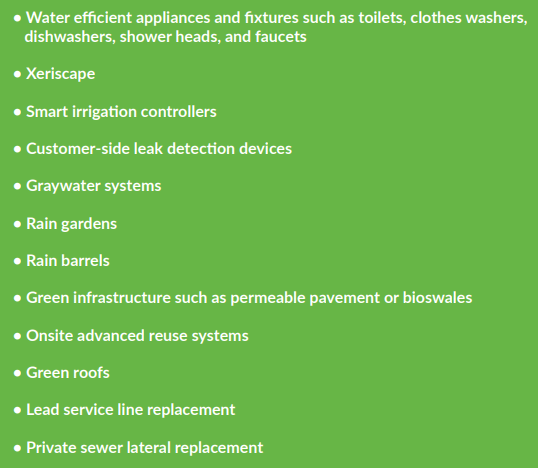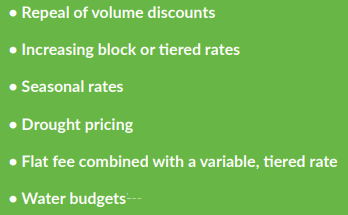Motivating Private Property Owners: Rates, Fees, and Financial Incentives
 Consumer Incentives
Consumer Incentives
The central tool at the disposal of public utilities for deploying onsite, localized and other distributed sustainable water management strategies is consumer incentives. While there will always be a certain number of early innovation adopters, or people who “want to do the right thing,” for the most part, significant, rapid and widespread deployment of onsite systems will require public utility investment.
Drinking water rates, stormwater fees, and other payments customers make to water utilities can play an important role in incentivizing private property owners to employ localized water infrastructure strategies. In the water supply and stormwater contexts, financial incentives include a broad range of rebates, reduced fees, or grants to encourage residential and non-residential customers to install a wide range of localize infrastructure strategies, including those shown in the box to the right.
range of rebates, reduced fees, or grants to encourage residential and non-residential customers to install a wide range of localize infrastructure strategies, including those shown in the box to the right.
Many utilities, including nearly all of the TiR Case Studies, have financial incentive programs that provide rebates for one or more of these solutions. For example, incentives for turf replacement with xeriscape implemented by the MNWD ranging from $3.00 to $3.50 per square foot with a total program budget of $2.5 million annually have helped the District change out 5 million square feet of turf saving 500 million gallons of water since 2012.150 SAWS’ WaterSaver Landscape Coupon Program, has replaced over 2 million square feet of water-intensive grass with low water-use plants and permeable patios. Tucson Water has invested $10 million in customer rebates and incentives over the past 10 years installing approximately 58,000 high efficiency toilets and clothes washers, 2,000 rainwater harvesting and graywater systems conserving a total of 2.1 billion gallons (6,446 acre-feet) of water to date. Austin Water’s program that offered rebates for all types of water efficient appliances and fixtures as well as a free efficient toilets that began in 1992 achieved 92% market saturation by 2010, and the utility intends to expand these rebates to include outdoor efficiency and conservation. Philadelphia implements a residential rebate and education program to incentivize homeowners to install green infrastructure on their property where homeowners can receive nearly 50% of the cost for installing downspout planters, rain gardens, or permeable pavers and for de-paving impervious surfaces as well as free rain; as of 2018, PWD has budgeted $25 million on incentives to residential customers for these private property retrofits and “greened” 980 acres of private property.
These “carrots” are proven implementation tools, and can be combined with conservation based rate structures and local ordinances or other legal mandates to further advance a local utility’s sustainability and water management goals.
Leveraging Rates & Fees
Virtually all public water resource management entities, whether special districts, commissions, city or county governments, are legally empowered to establish rates for drinking and/or wastewater services. Stormwater is often in a distinct category; some local entities have the legal authority to establish rates or fees to manage stormwater but many do not and are therefore dependent on the public’s willingness to enact stormwater fees.
Drinking Water Rates
Drinking water utilities set rates, i.e., the amount the water provider charges its customers to cover the costs of treating and delivering drinking water. These rates can be collected in a  variety of ways, including as flat fees, uniform volumetric rates, or block or tiered rates. Historically, volumetric rates were the most common. These rate structures can be set to promote conservation, i.e., “conservation pricing.” While water—an essential resource—is “inelastic,” conservation pricing can yield on average a 15% reduction in water consumption and up to a 22% reduction in per capita use. There are several rate structure options cities and utilities have increasingly put into practice, including those shown in the box to the left. Finding the right price and rate structure can be challenging as utilities rely on rate revenues to operate and decreased water consumption can mean reduced funds for delivery and treatment of water; certainly, this is not a novel issue. Responding to this reality has been the subject of many convenings and reports since the mid-1990s. Indeed, pricing policies making water more expensive, at least at higher tiers, inherently incentivizes business and residential consumers to use water more efficiently, either through technology or behavior changes. For example, SAWS uses a tiered rate structure to incentivize lower water consumption, together with other efficiency programs. Over the past 25 years, SAWS customers have reduced their consumption by nearly half from 225 gallons per capita per day (GPCD) to 117 GPCD. And communicating with ratepayers early and often about rate increases and conservation efforts is essential.
variety of ways, including as flat fees, uniform volumetric rates, or block or tiered rates. Historically, volumetric rates were the most common. These rate structures can be set to promote conservation, i.e., “conservation pricing.” While water—an essential resource—is “inelastic,” conservation pricing can yield on average a 15% reduction in water consumption and up to a 22% reduction in per capita use. There are several rate structure options cities and utilities have increasingly put into practice, including those shown in the box to the left. Finding the right price and rate structure can be challenging as utilities rely on rate revenues to operate and decreased water consumption can mean reduced funds for delivery and treatment of water; certainly, this is not a novel issue. Responding to this reality has been the subject of many convenings and reports since the mid-1990s. Indeed, pricing policies making water more expensive, at least at higher tiers, inherently incentivizes business and residential consumers to use water more efficiently, either through technology or behavior changes. For example, SAWS uses a tiered rate structure to incentivize lower water consumption, together with other efficiency programs. Over the past 25 years, SAWS customers have reduced their consumption by nearly half from 225 gallons per capita per day (GPCD) to 117 GPCD. And communicating with ratepayers early and often about rate increases and conservation efforts is essential.
Wastewater Rates
How wastewater utilities approach rates varies widely. Many utilities establish consumer rates; others collect all or part or of their revenues via property taxes. Another common practice is to impose a fee based on parcel-size or amount of water put into the wastewater system. Approaches can also differ within a city or utility depending on whether a customer has metered or non-metered use or according to the type of property i.e., residential or commercial, being charged. The University of North Carolina School of Government’s Environmental Finance Center has created a “Rates Dashboard” designed to help utility managers and local officials compare and analyze water and wastewater rates against multiple characteristics, including utility finances, system characteristics, customer base socioeconomic conditions, geography, and history.
The amount of wastewater flowing through the system is an important factor in the cost of collection, transport and treatment of wastewater discharges. Accordingly, in the context of sustainable water management, it is important to consider the question of how wastewater rates will be impacted by reduced water use or onsite reuse through advanced localized treatment. Depending on the governance and rate structure, this may mean that drinking water and wastewater utilities will need to coordinate rate planning because reduced water use leads to less wastewater.
Stormwater Fees
Cities and towns employ a variety of funding mechanisms to operate stormwater systems in their service areas, including general funds, bond proceeds, and stormwater fees—a user fee charged to property owners within the municipality’s service area specifically to finance the cost of stormwater program implementation. Stormwater fees can be structured in several ways, including those listed on the right.
ways, including those listed on the right.
Residential property owners generally support a “imperviousness-based fee models” taxes based on assessed property value according to some research. Impervious area-based stormwater fees may be generally more preferable from a policy perspective because they link the use of the stormwater system with the cost of operating and maintaining it and can more readily be coupled with financial incentives designed to encourage reduced impervious areas in exchange for reduced fees.
Some analysts maintain that “stormwater fees are the best option to fund stormwater-related improvements [because a] properly calibrated fee can provide a dedicated, long-term funding stream for stormwater management.” It also and “creates fewer accounting and planning hurdles than debt financing and provides steadier funding than a municipal general fund.” As of 2018 there are an estimated 1,400 to 2,000 cities across the country that have established a stormwater fee that is collected and administered either by a separate stormwater utility or as a stormwater department of an existing Public Works department. This funding mechanism is still emerging and 41 of 50 states authorize municipalities and counties to establish stormwater fees. Stormwater utilities and fees appear to be gaining momentum, however. These are proven tools for implementing localized water strategies, as they motivate ratepayers to conserve water or create a dedicated revenue source that can be leveraged for deploying distributed infrastructure projects on both public and private property.
As with rebates and other financial incentives, pricing mechanisms can also be combined with local ordinances or other legal mandates to further advance a local utility’s sustainability goals. To read more about local ordinances, check out the TiR Toolkit module on Mandates.

A WaterNow Alliance Initiative
Whether you have a project that needs support or are just dipping your toe in, our team of experts is here to help.